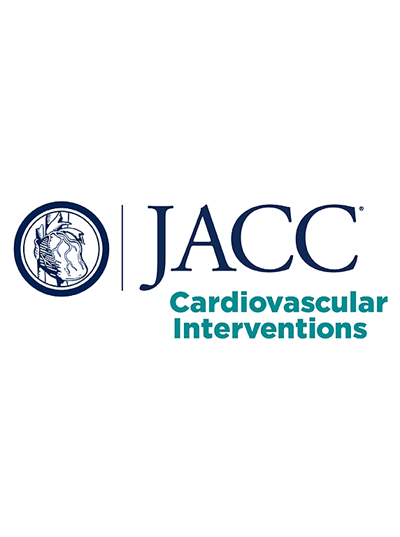Intravascular Imaging vs Angiography Guidance for PCI of Severely Calcified Lesions
IF 11.4
1区 医学
Q1 CARDIAC & CARDIOVASCULAR SYSTEMS
引用次数: 0
Abstract
Background
Few studies have examined whether intravascular imaging (IVI) guidance during percutaneous coronary intervention (PCI) of calcified lesions improves clinical outcomes.
Objectives
The aim of this study was to determine from a large-scale randomized trial of PCI in severely calcified lesions whether IVI guidance improves event-free survival.
Methods
In the ECLIPSE (Evaluation of Treatment Strategies for Severe Calcific Coronary Arteries: Orbital Atherectomy vs. Conventional Angioplasty Technique Prior to Implantation of Drug-Eluting Stents) trial, 2,005 patients with severely calcified lesions were randomized to orbital atherectomy (OA) vs balloon angioplasty (BA) prior to drug-eluting stent placement. IVI with optical coherence tomography or intravascular ultrasound (IVUS) was allowed at operator discretion. The primary clinical outcome was the 1-year rate of target vessel failure (TVF).
Results
IVI guidance was used in 1,246 of 2,005 patients (62.1%), including optical coherence tomography in 819 and/or IVUS in 513, while 759 of 2,005 patients (37.9%) underwent PCI with angiographic guidance alone. Median follow-up duration was 365 days (Q1-Q3: 365-365 days). The 1-year Kaplan-Meier estimated rate of TVF was lower among patients with IVI guidance compared with angiographic guidance alone (9.3% vs 13.2%; adjusted HR: 0.74; 95% CI: 0.56-0.97; P = 0.03). The effect of IVI guidance was consistent in patients randomized to OA vs BA (Pinteraction = 0.48). The 1-year rate of TVF was 7.7% after optical coherence tomographic guidance compared with 12.2% after IVUS guidance (adjusted HR: 0.78; 95% CI: 0.52-1.18; P = 0.24).
Conclusions
IVI guidance during PCI of severely calcified lesions was associated with improved 1-year clinical outcomes compared with angiographic guidance alone, whether OA or BA was used for vessel preparation prior to drug-eluting stent placement. The adjusted difference in 1-year TVF rates were not significantly different with optical coherence tomographic guidance and IVUS guidance.
严重钙化病变PCI的血管内显像与血管造影指导
背景:很少有研究探讨钙化病变经皮冠状动脉介入治疗(PCI)期间血管内成像(IVI)指导是否能改善临床结果。本研究的目的是通过一项大规模随机试验来确定IVI指导是否能提高严重钙化病变的无事件生存率。方法在ECLIPSE(严重钙化冠状动脉治疗策略评估:药物洗脱支架植入前的眶动脉粥样硬化切除术与常规血管成形术)试验中,2005例严重钙化病变患者被随机分配到药物洗脱支架植入前的眶动脉粥样硬化切除术(OA)和球囊血管成形术(BA)。根据操作者的判断,允许使用光学相干断层扫描或血管内超声(IVUS)进行IVI。主要临床结果为1年靶血管衰竭率(TVF)。结果2005例患者中有1246例(62.1%)采用了血管造影引导,其中光学相干断层扫描819例,IVUS 513例;2005例患者中有759例(37.9%)采用了血管造影引导。中位随访时间为365天(Q1-Q3: 365-365天)。IVI指导患者的1年Kaplan-Meier估计TVF发生率低于单独血管造影指导患者(9.3% vs 13.2%;调整后HR: 0.74; 95% CI: 0.56-0.97; P = 0.03)。IVI指导的效果在随机分配到OA和BA的患者中是一致的(p交互作用= 0.48)。光学相干断层引导后1年TVF发生率为7.7%,而IVUS引导后1年TVF发生率为12.2%(校正HR: 0.78; 95% CI: 0.52-1.18; P = 0.24)。结论在严重钙化病变PCI治疗中,无论是在药物洗脱支架置入前使用OA还是BA进行血管准备,与单独的血管造影指导相比,sivi指导可改善1年临床结果。光学相干层析引导与IVUS引导的1年TVF率调整差异无显著性差异。
本文章由计算机程序翻译,如有差异,请以英文原文为准。
求助全文
约1分钟内获得全文
求助全文
来源期刊

JACC. Cardiovascular interventions
CARDIAC & CARDIOVASCULAR SYSTEMS-
CiteScore
11.60
自引率
8.80%
发文量
756
审稿时长
4-8 weeks
期刊介绍:
JACC: Cardiovascular Interventions is a specialist journal launched by the Journal of the American College of Cardiology (JACC). It covers the entire field of interventional cardiovascular medicine, including cardiac, peripheral, and cerebrovascular interventions. The journal publishes studies that will impact the practice of interventional cardiovascular medicine, including clinical trials, experimental studies, and in-depth discussions by respected experts. To enhance visual understanding, the journal is published both in print and electronically, utilizing the latest technologies.
 求助内容:
求助内容: 应助结果提醒方式:
应助结果提醒方式:


